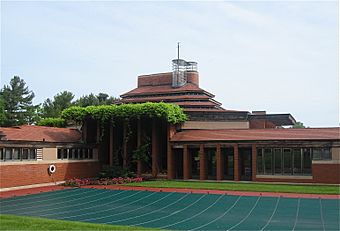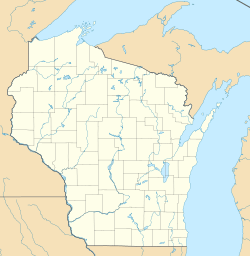Wingspread facts for kids
|
Herbert F. Johnson House
|
|
 |
|
| Nearest city | 33 East Four Mile Road, Wind Point, Wisconsin, U.S. |
|---|---|
| Area | 30 acres (12 ha) |
| Built | 1938–1939 |
| Architect | Frank Lloyd Wright |
| Architectural style | Prairie School |
| NRHP reference No. | 75000076 |
Quick facts for kids Significant dates |
|
| Added to NRHP | January 8, 1975 |
| Designated NHL | June 29, 1989 |
Wingspread is a famous house and conference center in Wind Point, Wisconsin. It was designed by the well-known architect Frank Lloyd Wright and built between 1938 and 1939. The house was made for a businessman named Herbert Fisk Johnson Jr., who was the president of S.C. Johnson. Wingspread is one of the biggest homes Wright ever designed, covering about 14,000 square feet. Wright even called it his last "Prairie style" house. Since 1960, Wingspread has been used as a special place for meetings and learning, run by the Johnson Foundation. It is also recognized as a National Historic Landmark, which means it's a very important historical place.
What is Wingspread?
Wingspread, also known as the Herbert F. Johnson House, is located at 33 East Four Mile Road in Wind Point, Wisconsin. It sits on a piece of land that sticks out into Lake Michigan, just north of Racine. The property is quite large, covering about 30 acres. The house is surrounded by green areas, a ravine, and ponds. Some parts of the land are kept as neat lawns, while others are left wild to attract birds. When the house was built, a stream separated it from nearby farms.
The estate also has cool sculptures by different artists. For example, there's a sculpture called Amanti (1964) that shows two young lovers. Another one is Primavera (1966), a bronze figure of a woman. There's also Quartet (1966), a large bronze sculpture with four abstract figures.
Besides the main house, there are other buildings on the property. These include an office building and places for storage. In 2002, a 40-room hotel called the Guest House was built. This hotel is for people who come to Wingspread for conferences. The Guest House was designed to look similar to Wingspread.
How the House Looks
The house was designed by Frank Lloyd Wright, who said it was his last "Prairie style" house. Wright named the house "Wingspread" because it looks like it's spreading its wings. The house has a central living room, which is shaped like an octagon. From this center, four "wings" spread out like a pinwheel. This design was different from some of Wright's other buildings.
Outside the House
The outside of Wingspread is mostly made of red brick from Illinois. The bricks are slightly curved, which creates cool shadows. The house also has horizontal lines of stucco and sandstone, and the roof tiles are red. There are wooden boards and vine-covered walkways made of cypress wood, which is good because it resists rotting.
Wingspread has about 500 windows! They are placed to give the best views of the nature around the house. The living room has very tall windows, about 16 feet high. The roof has three levels of windows, called clerestory windows, which let in a lot of light.
The main entrance to the house is a bit hidden, which was common in Wright's designs. It's also smaller than the big rooms inside. The house has a unique, oval-shaped chimney that rises 30 feet high. At the very top of the chimney, there's a glass "crow's nest" or observatory. Johnson's children used to go up there to watch their dad work or to look at the lake.
There's also a swimming pool next to the house with an outdoor fireplace. The pool is very long, about 125 feet by 25 feet. Wright wasn't a big fan of swimming pools, but he included it because the Johnson family wanted one.
Inside the House
Wingspread is huge, with about 14,000 square feet of space. The inside walls are made of red brick and pink sandstone. The plaster walls have a special wax finish that gives them a rust-rose color. The ceilings are also plaster, with a mustard-yellow wax finish. Much of the furniture was custom-made for the house. The wood inside is American oak, arranged horizontally to show off the design.
The four wings of the house were originally designed for different purposes. This was Herbert Johnson's idea. One wing was for the master bedroom, one for service rooms (like the kitchen), one for guest rooms, and one for the children's rooms. The entrance doorway is only about 6 feet tall, and there are seven fireplaces in the house. Wright even designed special lamps and chairs for Wingspread.
The Living Room
The center of the house is the large living room, sometimes called the Great Hall. It's about 40 by 60 feet. The floor is made of large red tiles. Glass doors on all sides of the living room open up to outdoor areas. The living room has built-in couches and other unique furniture.
The main chimney is in the middle of the living room, with five fireplaces around it. Four are on the main floor, and one is on an upper level. Wright called the living room a "wigwam" because the chimney opening on the roof looked like a Native American wigwam's smoke hole. Next to the chimney, there's a spiral staircase that leads up to the glass observatory.
The living room is divided into different areas by low walls. The original dining area was part of the living room, next to the kitchen wing. There's also a cozy sitting room with a low ceiling and a library under an upper level. The living room ceiling is domed and about 30 feet high.
The Wings
The master bedroom wing is to the north and has five rooms. Johnson's daughter, Karen, even had a sleeping area on a balcony level.
The guest wing is to the west, near the garage, which could fit four or five cars. The service wing is to the south and includes the kitchen and rooms for staff. The east wing was originally for the Johnson children and had a playroom.
After Wingspread became a conference center in 1960, the wings were changed. Two wings became offices for the foundation, and the other two became conference spaces. The kitchen area is still a kitchen, but the rest of that wing is now offices. The west wing is also used for offices. The east wing is used for large meetings, and the north wing has smaller meeting rooms. The conference center also has dining areas, a library, and a theater.
History of Wingspread
Wingspread was built for Herbert Fisk Johnson Jr.. He had already asked Frank Lloyd Wright to design the Johnson Wax Headquarters in Racine. Wright reportedly offered to build Johnson a house because Johnson loved the Administration Building so much. Johnson and his wife, Jane Roach, had four children, and they needed a bigger home.
A Family Home
Work on Wingspread started in May 1938. Sadly, Jane Roach passed away during construction, and Johnson almost stopped the project. But he decided to finish it. The house was completed in 1939. The completion of Wingspread and the Johnson Wax Headquarters helped Wright's career, which had slowed down.
The Johnson children eventually loved living in the house. Sam Johnson, Herbert's son, said his friends would bike over to play. The observatory and Karen Johnson's balcony were added at the children's request.
The house did have some issues, like leaks. There's a famous story that when the roof leaked during a party, Herbert Johnson called Wright, and Wright supposedly told him to just move his chair! The heating system under the floor also didn't work well and had to be removed.
The Johnson family lived at Wingspread for 20 years. They hosted famous guests, like ballet dancers. In 1941, Johnson married his third wife, Irene Purcell, who moved into the house. She tried to redecorate, but Wright reportedly removed her decorations early one morning! The Johnson family moved out of Wingspread in 1959.
A Conference Center
In 1960, the Johnson family gave Wingspread to the Johnson Foundation. The house was changed a little to become a conference center. Restrooms were added, the garage became offices, and the playroom became a conference room.
Wingspread hosted its first big meeting in November 1960. The conference center was officially opened on June 24, 1961. It quickly became a popular place for discussions on many topics, like education and international relations. Famous visitors included former U.S. first lady Eleanor Roosevelt. Important organizations like the National Endowment for the Arts and National Public Radio were even started during meetings at Wingspread in the early 1960s.
In the 1990s, the living room's roof started to sag because of heavy ice in winter. The Johnson Foundation had to close the living room for repairs. Workers used new materials like carbon fiber to fix the roof without changing its historic look. Wingspread reopened in June 1997 after the repairs were finished.
In 2002, the Guest House hotel was opened on the Wingspread campus. This allowed people attending conferences to stay right there. Wingspread continues to host important meetings and events today.
How Wingspread is Managed
Wingspread is run by the Johnson Foundation, a group that helps organize meetings and discussions. The foundation was started in 1959. It gets money from S. C. Johnson & Son and the Johnson family.
Conferences
The Johnson Foundation helps plan conferences and meetings at Wingspread. They even help with travel and lodging for visitors. The conferences focus on topics like education, society, and international relations. Important people from all over the world have attended meetings there. The kitchen staff at Wingspread prepares meals for events, and they can make special foods if needed. The center also hosts concerts, exhibits, and talks for the local community.
The foundation used to publish a newsletter called the Wingspread Journal with highlights from meetings. They also had a radio series called Conversations from Wingspread, which won awards.
Tours
Wingspread is also open for public tours. You need to book in advance. If a conference is happening, you might only be able to tour the grounds. Guides show visitors the special parts of the house. As of 2023, free tours of Wingspread were offered three times a day, five days a week, when no other events were taking place.
Why Wingspread is Important
When Wingspread was first built, people called it "timeless architecture." Some even said it looked like a ship floating on waves. Others thought it was a "true folly" that didn't fit its site. But many agreed that it was a unique and interesting building.
Writers have praised how the wood and brick blend together. One writer said that "nature and structure seem to have been living in perfect harmony" at Wingspread. It's considered one of Frank Lloyd Wright's most important country houses.
As a conference center, Wingspread has been very successful. People have said it made the change from a home to a meeting place easily. It's seen as a peaceful place where people can find common ground, even during tough discussions.
Wingspread is featured in several books and a PBS documentary. It was added to the National Register of Historic Places in 1975 and became a National Historic Landmark in 1989. It's also part of the Frank Lloyd Wright Trail in Wisconsin, which highlights places designed by Wright.
See also
- List of Frank Lloyd Wright works
- List of National Historic Landmarks in Wisconsin
- National Register of Historic Places listings in Racine County, Wisconsin



